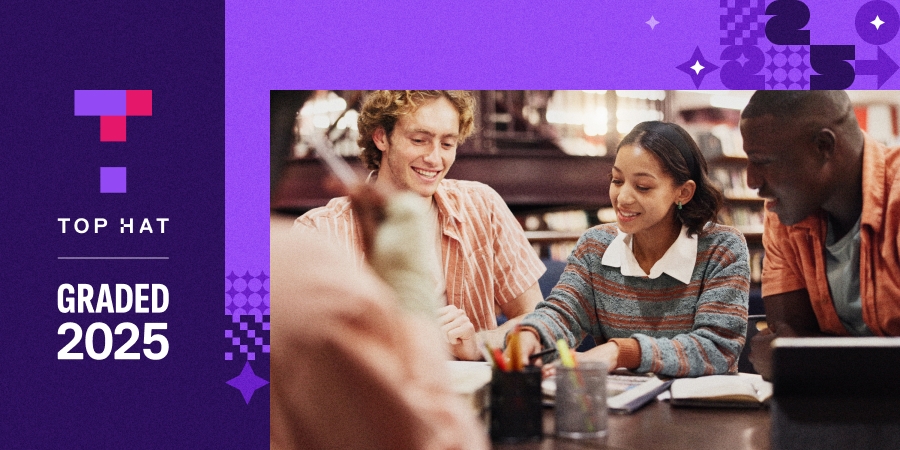Today’s higher ed students are members of Generation Z—digital natives who are accustomed to technology in every facet of their lives. To have a real stake in their own education, Generation Z will benefit from dynamic, immersive learning experiences and the ability to engage and collaborate with their peers.
As college courses transitioned online due to the COVID-19 pandemic, the need for flexible tech-based learning activities for engaging students inside and outside the classroom has surged. The right tech-based learning tools and platforms provide students with an immersive experience that matches the way they’ve become accustomed to learning. It also makes it easy to teach online, providing instructors with valuable real-time insights into student progress and understanding.
Switching from a face-to-face classroom to an online course requires adjustment for instructors and students alike. If the medium is the message, then you can’t replicate the exact same lecture you had planned for a face-to-face classroom in the online world—at least not without making a few adjustments that will benefit student learning. Moving into online teaching requires an agile approach. Here are four ways instructors can leverage the tools that students are already comfortable with to create high-quality and dynamic learning experiences in the virtual classroom.
1) Temperature checks
Insight—and the feedback it generates—is essential in online or hybrid courses, helping online teachers tailor the learning experience to student needs. Feedback, when combined with frequent testing, is equally important for students who want to know where they are excelling and where to focus their study efforts for future assignments.
Frequent, low-stakes assessments or ‘temperature checks’ give students a number of chances to demonstrate their comprehension of course concepts as the term progresses. Gauging individual student success early and often—and acting on insights—has been shown to significantly impact student retention. These regular evaluations also provide online instructors with an opportunity to share specific feedback on areas to improve, rather than just a percentage or letter grade. These progress checks can be collected in an active learning platform like Top Hat or in learning management systems to track individual student success.
To get regular insights on student understanding, have students complete a short ten-minute pre-lecture assignment on their laptops or cellphones. Comprehension checks—in the form of polling or discussion questions—can also be interspersed between lecture slides so instructors can see how students are feeling about newly introduced course concepts, even in online environments. Click here to learn about how Frank Spors, professor at Western Health Sciences University, increased student outcomes with pre-lecture assignments in Top Hat.
2) Anonymous discussions
Today’s college students are much less tolerant of a one-size-fits-all approach to their college education. For instructors, this means shifting from a homogeneous approach to one that is more personalized. Customizing courses based on student learning styles also plays a role in creating inclusive classroom experiences. Promoting inclusivity is ultimately about embracing the different identities, backgrounds and lived experiences that students bring to their classrooms. This starts with equipping educators with the means to understand important and often invisible differences among students in online classrooms.
Online polling questions and anonymous discussion threads make it easier to capture the diversity of lived experiences and viewpoints throughout the learning process—even when course material may be polarizing or sensitive in nature. This, in turn, creates a more empathetic teaching and learning environment. Questions and discussion threads can be interspersed with lecture slides, so students who are tuning in asynchronously can participate as well. These interactions generate student data that can be used by instructors to provide timely feedback and tailor future course content.
3) Peer-reviewed assignments
Helping Gen Z engage with course material starts with active learning. As part of creating engagement with students, it is important that they learn to give, as well as receive, constructive feedback from their peers as part of the grading process. Peer-reviewed assessments help students develop higher-order thinking skills and make evaluative judgments based on assignment criteria. In giving and receiving feedback, students strengthen essential soft skills that help prepare them for further academic pursuits and professional life.
Instructors can assign small groups or partners to review one another’s work as a part of online instruction. This can also be helpful for video assignments, which are purpose-built to assess soft skills, as well as an understanding of course concepts.
This exercise—where students are both giving and receiving—builds their investment in coursework. It also clarifies the relationship between their assignments and where they can improve. Students are made to engage with course content in different ways, which encourages the self-reflexivity that strengthens their critical thinking skills over the course of their online education. Peer-reviewed assignments are designed to help students develop into lifelong thinkers and writers who learn to question their own work, values, and engagement instead of simply responding to assignment instructions.
4) Discussion forums
Generation Z is highly collaborative and approaches learning with a community-based mindset. They enjoy learning from their peers as well as their instructors and often comprehend course material better in a group setting. Discussion forums and chat channels give students the opportunity to talk about course topics with each other and with the professor, replicating the feel of a traditional classroom. Opportunities for discussion can be interspersed with lecture slides, to break up course content into more digestible chunks.
Virtual discussions help students absorb the class material and share ideas with one another. Students are able to gather their thoughts and ideas before sharing their reflective responses. Discussion forums are also a flexible option for engagement in asynchronous classes, as students can add their responses when they view lecture videos on their own time.
Discussions forums build community with peers and faculty members in online learning environments. They create opportunities for students to practice and sharpen a number of skills, including the ability to articulate and defend positions, consider different points of view, and create in-depth reflective responses. Discussion threads give all students a voice, especially those who are normally quiet in a face-to-face classroom environment, and those who need more time to compile their thoughts or want to avoid potential conflict or disagreement. They empower students to view and respond to their peers in a safe and respectful manner.
Looking forward to fall
Tech in the classroom plays to Generation Z’s strengths. They are collaborative and community-minded and expect the concepts they learn to be tailored to them, similar to the content they consume or the items they buy. For higher education institutions, the challenge of replicating this may seem daunting, particularly in online learning environments. Shifting from a homogeneous approach to one that is more personalized does require new tools and approaches but with careful consideration and thoughtful design, students can experience a dynamic personalized college experience, wherever learning takes place.


